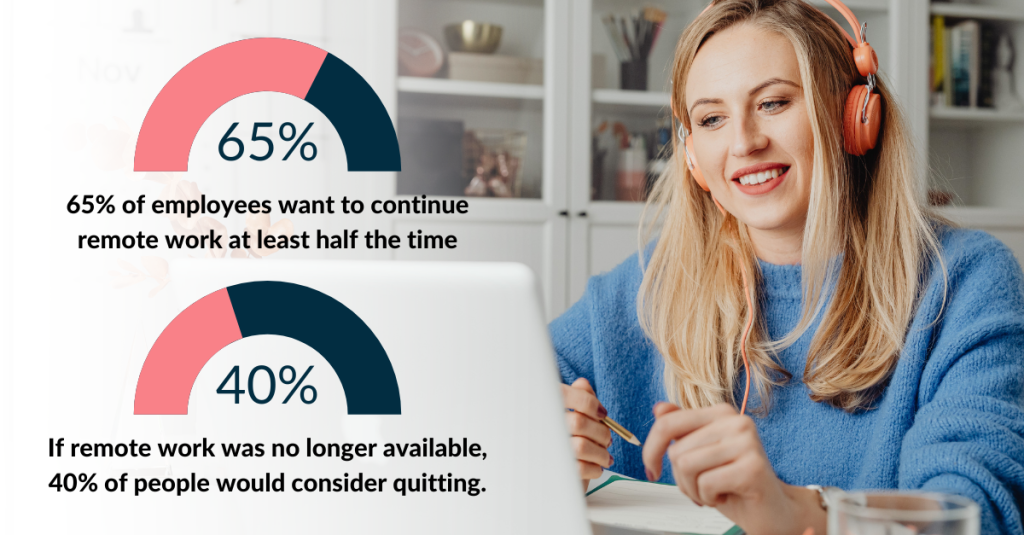In our last blog, we discussed how 2023 has seen a trend in more companies encouraging or even requiring a return to office for new and existing staff as the world emerges from the pandemic and re-evaluates its relationship to work. The first side of this story arose from conversations we’ve had with our clients–companies in the insurance industry who are amidst hiring and retention efforts. Many of them believe that going back to the office will improve work culture, accountability, productivity and provide more opportunities for professional development.
But what employers want is not the only side to the story. We also spend much of our time building relationships with candidates and employees who give us great clues into what can make one company or job more attractive than another, and their thoughts on the return to office are quite different. In part 2 of this blog, we’ll focus on the employee perspective and their reasons for favoring remote or hybrid work.
We can debate the pros and cons of remote work all day, but the real question is do employees actually want to return to largely in-person work? The answer is complicated, as it depends on exactly what employers mean when they say “return to office.” For some, virtual work opened opportunities to take jobs outside their physical location, or to relocate while keeping their current job. Going back to the office isn’t just objectionable, but often impossible for these employees and employers should be aware of these factors when planning potential in-person requirements.
Even those within commuting distance of their offices only want the return to office to be a portion of their work schedules. More than 65% of employees who worked remotely during the depths of the pandemic want to work from home half the time more permanently. In fact, our own survey on LinkedIn found that 72% of people think remote work and flexible schedules are key factors when evaluating a potential employer.
The option to work remotely isn’t just a want, it’s a new standard for some–40% of employees would consider leaving their current role if remote work was not available at least some of the days out of their week. Obviously the ability to work remotely has become deeply important to workers in 2023 and forcing a return to office could pose a huge risk to retention for employers. But it’s also clear that employees aren’t outright unwilling to go back to the office. They are largely advocating for a flexible combination of remote and in-person work. But before employers shrug this off, let’s get into why employees are in favor of remote vs in person work.

With almost three years of remote work under our belts we have a much better understanding of how it has impacted people and businesses, with numerous studies to provide quantitative and qualitative data. While there has always been fear around the consequences of virtual work, these studies show that there are many benefits to remote work and are reinforced by the conversations we have with employees on a daily basis. Here are some of the top reasons employees prefer remote work.
With tempting distractions like your comfy couch, pets, and family members, many employers were concerned that productivity in a home work environment would decrease. But the reality is just the opposite. A Stanford study found that remote workers increased their productivity by 13% compared to in-office work. Likewise, ConnectSolutions surveyed remote workers and found that 54% of them reported being able to do more work in the same or less time than while working in person. These astonishing results for remote work productivity are born from many different factors. Eliminating stress, increasing convenience, and allowing workers the flexibility to take breaks and work how it best suits them are just a few.
Remote work can lead to substantial cost savings for both employees and employers. Without the need to commute, employees save on transportation costs, child care and expenses related to office attire and meals. 38% of remote workers surveyed by FlexJobs estimate they are saving at least $5,000 per year by working from home. This is just one of the reasons why some remote work employees are even willing to take a pay cut to continue working from home. Employers experience this benefit too, reducing overhead costs associated with office spaces, amenities and utilities.

Each human being is unique and their needs in a work environment can vary greatly. There’s a good reason why large offices full of uniform cubicles are the butt of many jokes and much disdain. While it’s harder to measure, one of the benefits of remote work is that it allows each unique employee to craft a work environment and schedule that best fits their needs. If you work best with short intense work periods and many breaks, work-from-home gives you the freedom to do that. Others prefer to start their days in the wee hours of the morning and free up their afternoons for personal pursuits. A midday workout might reinvigorate you to work more productively into the evening.

There are especially benefits of this flexibility for parents. The ability to pick kids up from school or take them to daytime doctor’s appointments has made an immense difference in many of the employees we work with. In speaking with female candidates we’ve also found that the flexibility of remote work has empowered them to advance their careers in ways they could not when balancing parenthood with in-person work. This alone is an incredible reason why employees choose remote vs in person work, and why employers should pay close attention to their staff’s wants.

Just as remote work has its benefits, in-person work also has its challenges for employees that are equally important to consider. The Washington Post published an article diving into return to office anxiety and how we must treat going back to the office with great care. Social anxiety has been a challenge for many even before the pandemic but after more than two years out of practice, social spaces like an office can be incredibly daunting. There are lots of great ways to mitigate return to office anxiety, but many of them rely on conscious and supportive employers to make going back to the office successful.
Not to mention that there are still almost 20,000 Covid cases per day in the US and health and safety concerns should be top of mind for employers requiring any amount of in-person work. What safety requirements will you have in place? What is your policy around workers who are sick or exhibiting symptoms? Our switch to remote work occurred urgently, but moves back to the office should be approached slowly with care.
The ability to work remotely is important for an employee’s productivity, work-life-balance, job satisfaction and is even a key decision making factor when applying for new jobs. Employers who are eager to return to office should bear all of this in mind and consider adopting a hybrid work model to continue reaping the benefits of remote work while improving team collaboration and development. When in doubt, talk to your staff members about what they want out of their work environment and the compromises they’re willing to make to meet the company’s goals.
And as always, if you want to learn more about how your business can leverage remote work flexibility to attract qualified candidates for open positions, get in touch with our expert insurance recruiting team.